Navigate to Standards → Main → Other → IACS UR S35 Plate Buckling (2023). Custom settings can be adjusted from the Help panel.
Instantly perform direct strength analysis on unstiffened plates based on IACS UR S35 guidelines — no spreadsheets required.
Built-in logic transforms element stresses into plate directions (X, Y, XY) automatically for consistent, standards-aligned results.
Panel Finder detects and measures plate sections across complex ship structures — ready for immediate buckling evaluation.
Built-in safety factors, slenderness coefficients, and plate dimensions ensure your model meets IACS classification requirements out of the box.
Generate transparent, standards-based reports with visual plate plots, flow tables, and critical buckling zones highlighted.

The IACS UR S35 standard—issued by the International Association of Classification Societies—defines mandatory rules for evaluating the buckling strength of unstiffened plates used in ships and offshore structures. It ensures that plate elements can withstand compressive, in-plane, and shear forces without failure.
Objective: Prevent buckling-related failures in marine and offshore environments by establishing a uniform strength assessment methodology.
Scope of Application:
Engineering Impact: By applying UR S35, naval architects and structural engineers can:
The 2023 revision (Corr. 1, Sep. 2024) reflects updated methods and safety factors for robust structural integrity in demanding offshore conditions.
ABS Standards
AIJ Standards
AISC Standards
API Standards
ASME Standards
Australian Standards
British Standards
Bureau Veritas Standards
DIN Standards
DNV Standards
DVS Standards
EN 13001 Standard
Eurocode 3
Eurocode 9
F.E.M. 1.001
FKM Standard
IACS Standards
ISO
Lloyd’s Register (LR) Standards
NORSOK Standards
VDI Standards
It’s a standard developed by the International Association of Classification Societies to evaluate the buckling strength of unstiffened plates in ships and offshore structures under various loading conditions.
Primarily shipbuilding and offshore engineering — particularly naval architects and structural engineers working on hulls, bulkheads, decks, oil rigs, and FPSOs.
Yes. The Panel Finder tool in SDC Verifier detects and defines sections and plates, streamlining the setup for buckling checks.
Yes, you can override default values and define plate thickness manually if needed.